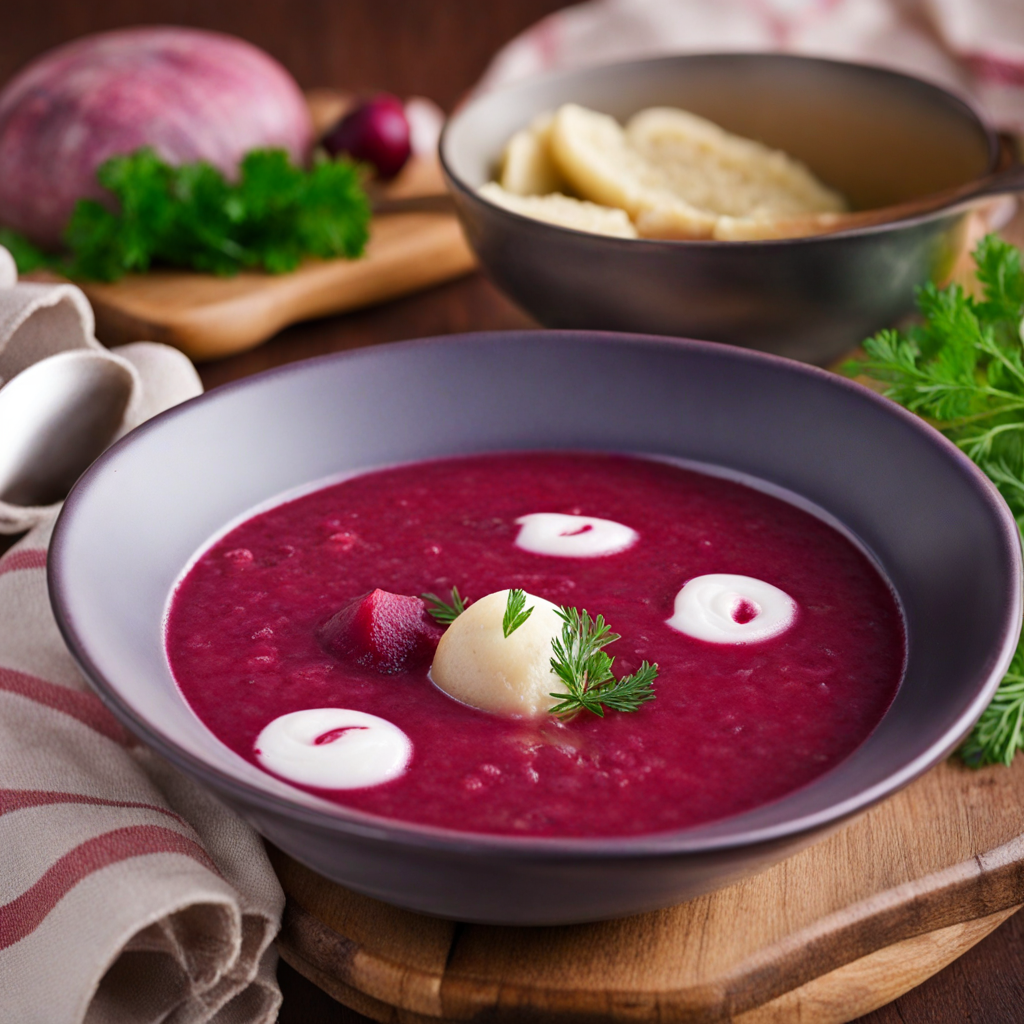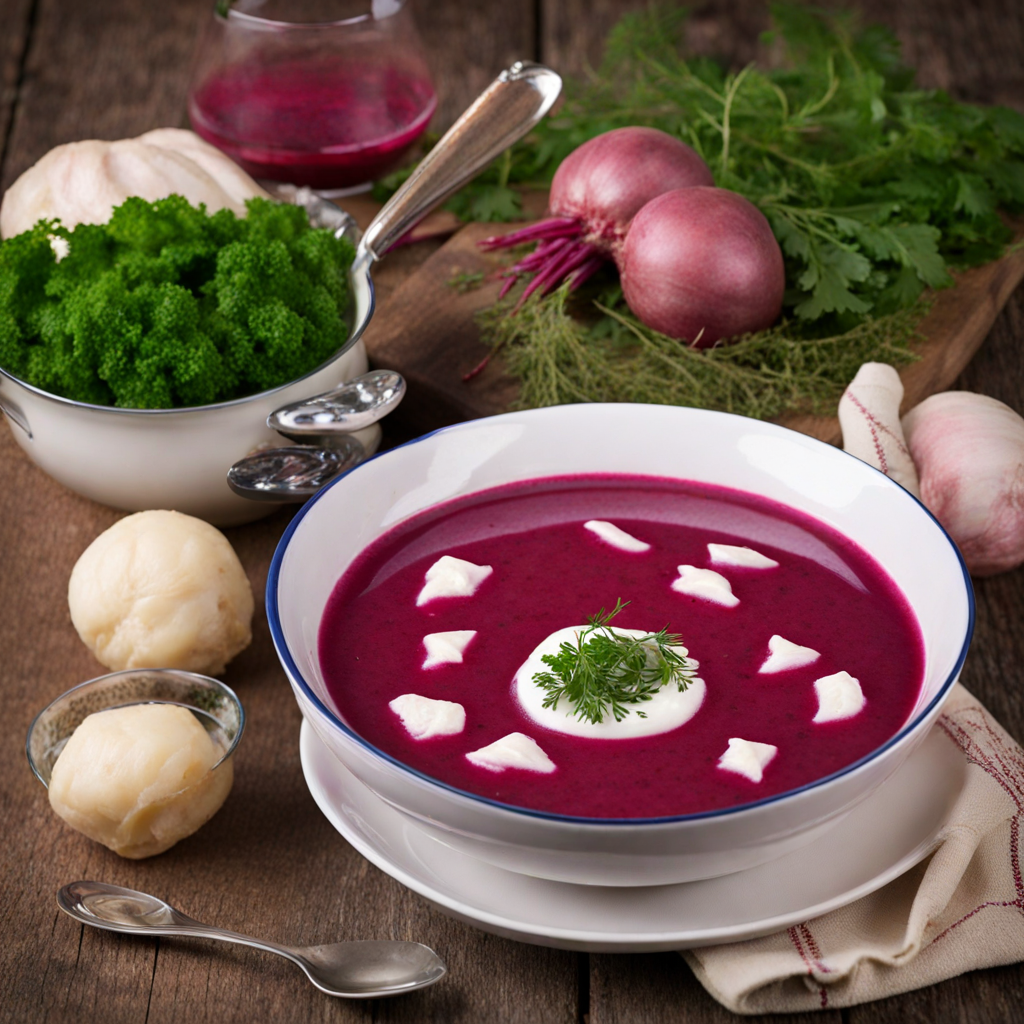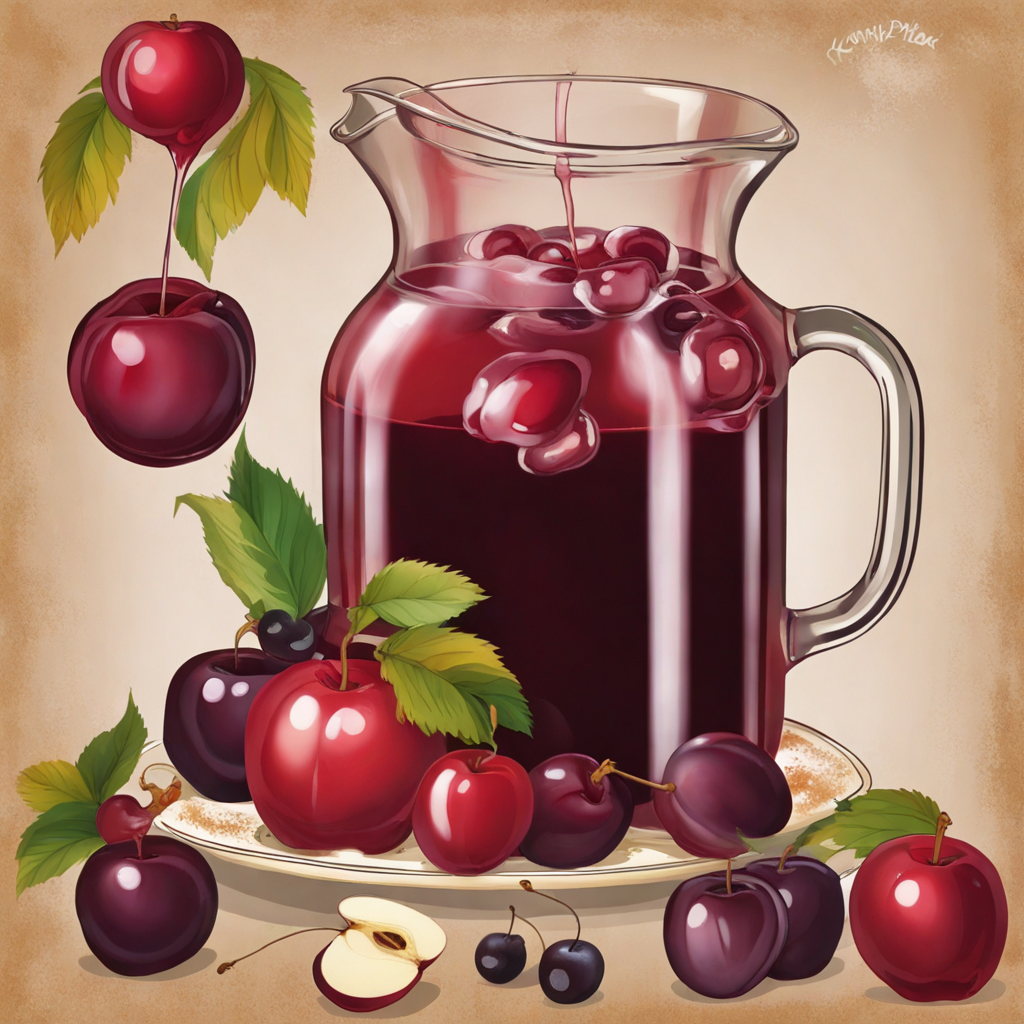Barszcz
Barszcz, often referred to as borscht in other cultures, is a vibrant and deeply flavorful beet soup that hails from Poland. The rich, ruby-red color of the soup is immediately striking, hinting at the earthy sweetness of the beets that form its base. Typically, barszcz is made with fresh beets simmered in a broth, which may be vegetable or meat-based, allowing the natural sweetness of the beets to shine through. The addition of other ingredients such as onions, carrots, and potatoes further enhances the complexity of flavors, while a splash of lemon juice or vinegar can add a delightful tang that balances the sweetness of the beets. What makes barszcz particularly special is its versatility. It can be served hot or cold, making it a perfect dish for any season. In Poland, it is often garnished with a dollop of sour cream, which adds a creamy texture and a slight tartness that complements the soup beautifully. Additionally, barszcz can be accompanied by uszka, small dumplings filled with mushrooms or meat, which add a satisfying bite and richness to the dish. This combination creates a comforting meal that warms the soul, especially during the chilly months. Barszcz is more than just a meal; it embodies the essence of Polish culinary tradition. It is often enjoyed during special occasions and family gatherings, symbolizing nourishment and togetherness. The soup's unique flavor profile, characterized by the earthy sweetness of beets and the tangy notes from the seasoning, invites those who try it into a world of comforting and hearty flavors. For anyone looking to explore new tastes, barszcz offers a delightful journey into the heart of Polish cuisine, celebrating both simple ingredients and rich cultural heritage.
How It Became This Dish
Barszcz: The Heart of Polish Culinary Heritage Origins and Historical Context Barszcz, often referred to as borscht in its broader Eastern European context, is a beetroot soup that serves as a testament to Poland’s rich culinary history. Its origins can be traced back to the ancient Slavic tribes, who utilized wild beets and various herbs in their cooking. The earliest records of barszcz date back to the 14th century, when it was mentioned in Polish texts. The name itself likely derives from the Old Slavic word “barščiai,” referring to the wild beet that is native to the region. Beetroot, the primary ingredient in barszcz, has been cultivated in Europe since antiquity, but it took root as a staple in Eastern European cuisine due to its adaptability to the local climate and soil conditions. The cultivation of sugar beets in the 19th century, particularly in Poland, further solidified the vegetable's importance in regional diets. The soup was not only a nourishing meal but also a symbol of the agricultural practices that defined the livelihoods of many Polish families. Cultural Significance Barszcz holds a significant place in Polish culture, often symbolizing home, comfort, and tradition. It is particularly associated with family gatherings, celebrations, and religious observances, notably Christmas Eve (Wigilia). During this time, a clear version of the soup, often served with uszka (small dumplings filled with mushrooms or sauerkraut), is a staple dish, representing the warmth and unity of family. The soup's vivid crimson color is also imbued with cultural meanings, symbolizing the blood of Christ in Christian traditions. In rural communities, it was customary to serve barszcz at special occasions, signifying abundance and hospitality. The dish has transcended its humble beginnings, becoming a beloved symbol of Polish national identity. Development Through Time As Poland underwent various political and social changes, so too did barszcz. The partitions of Poland in the late 18th century and the subsequent struggles for independence in the 19th and 20th centuries influenced culinary practices, leading to a fusion of regional flavors and ingredients. As Polish immigrants settled in other countries, they brought their culinary traditions with them, allowing barszcz to evolve and gain popularity beyond its borders. In the 19th century, barszcz began to take on various regional variations across Poland. In Greater Poland (Wielkopolska), for example, barszcz is often made with sour rye starter, giving it a tangy flavor, while in Lesser Poland (Małopolska), it is commonly prepared with mushrooms and served as a thicker, heartier version. The introduction of additional ingredients, such as cabbage, potatoes, or even meat, reflects the adaptability of the dish and the local preferences of different areas. During the interwar period, barszcz became a symbol of Polish identity in the face of foreign influences. Cookbooks began to emerge, documenting traditional recipes and promoting the soup as a national dish. The post-World War II era saw a resurgence of interest in traditional Polish cuisine, as the country sought to reclaim its cultural heritage. Barszcz became a staple in homes and restaurants, often featured in school cafeterias and institutional dining settings. Modern Interpretations In contemporary Poland, barszcz continues to be a cherished dish, enjoyed by generations both in homes and in restaurants. New interpretations have emerged, reflecting the global culinary trends and the increasing popularity of vegetarian and vegan diets. Chefs experiment with different varieties of beets, incorporating heirloom and specialty types, while also introducing novel garnishes and accompaniments. The modern culinary scene in Poland has embraced the soup, presenting it in innovative ways—served chilled in the summer months, sometimes garnished with fresh herbs or accompanied by a dollop of sour cream, or as a refined dish in upscale dining establishments, paired with artisanal breads or gourmet toppings. The versatility of barszcz allows for creativity while maintaining a connection to its historical roots. Culinary Techniques and Ingredients Traditional preparation of barszcz involves boiling beets, then straining the liquid to create a vibrant broth. The soup can be seasoned with garlic, onion, and a variety of herbs, including dill and parsley. It is typically finished with a splash of vinegar or lemon juice to enhance the flavor. In many households, it is common to use a sourdough starter, which imparts a unique tanginess to the soup. In addition to its many variations, barszcz can be served hot or cold, catering to the changing seasons and regional preferences. This adaptability is one of the reasons why barszcz continues to thrive in Polish cuisine, as it can be tailored to suit individual tastes and occasions. Global Influence and Legacy As Polish communities have spread across the globe, especially in the United States and Canada, barszcz has found its place in the international culinary landscape. Polish immigrants brought their recipes and traditions with them, and barszcz has become a beloved dish in many Polish-American households. Restaurants specializing in Polish cuisine often feature barszcz on their menus, introducing it to new audiences and ensuring its continued relevance. In recent years, the rise of food culture and the emphasis on traditional and artisanal foods have further elevated barszcz's profile. Food festivals celebrating Polish heritage frequently showcase the soup, allowing people to experience its diversity and cultural significance firsthand. Conclusion Barszcz is much more than just a soup; it is a reflection of Poland's rich history, cultural identity, and culinary evolution. From its humble origins among ancient Slavic tribes to its modern interpretations in kitchens around the world, barszcz remains a beloved symbol of Polish hospitality and tradition. As it continues to adapt and thrive, this vibrant beetroot soup will undoubtedly remain at the heart of Polish culinary heritage, cherished by generations to come.
You may like
Discover local flavors from Poland







